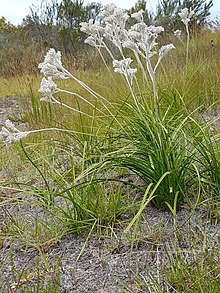| Lanaria | |
|---|---|

| |

| |
| Scientific classification | |
| Kingdom: | Plantae |
| Clade: | Tracheophytes |
| Clade: | Angiosperms |
| Clade: | Monocots |
| Order: | Asparagales |
| Family: | Lanariaceae H.Huber ex. R.Dahlgren & A.E.van Wyk[3] |
| Genus: | Lanaria Aiton[2] |
| Species: | L. lanata
|
| Binomial name | |
| Lanaria lanata (L.) T.Durand & Schinz[1]
| |
| Distribution map | |
| Synonyms | |
| |
Lanaria is a monotypic genus of flowering plants containing a single species, Lanaria lanata, endemic to the southern coast of South Africa where it is associated with the fynbos belt.[4][5][6] Lanaria lanata is commonly known as Cape edelweiss or lambtails. The genus is placed in the monotypic family Lanariaceae,[2] a family only recently recognized by taxonomists. The APG IV system of 2016 (unchanged from the 1998, the 2003 and 2009 versions) does recognize this family.[7][3]
This species occurs on clay and sandstone soils throughout its distribution range. The stiff, ribbed leaves arise from a woody rootstock and are evergreen, channelled, and finely serrate along the margins. The densely woolly, white heads enclose mauve flowers and are peculiar to the species. Flowering is profuse following fires.
- ^ a b Cite error: The named reference
WCSP_251718was invoked but never defined (see the help page). - ^ a b c Cite error: The named reference
WCSP_251717was invoked but never defined (see the help page). - ^ a b Cite error: The named reference
APG4was invoked but never defined (see the help page). - ^ 'Plants of the World: An Illustrated Encyclopedia of Vascular Plants'- Maarten J. M. Christenhusz, Michael F. Fay, Mark W. Chase
- ^ Cite error: The named reference
MillBlum11was invoked but never defined (see the help page). - ^ "Threatened Species Programme | SANBI Red List of South African Plants".
- ^ Cite error: The named reference
APG3was invoked but never defined (see the help page).